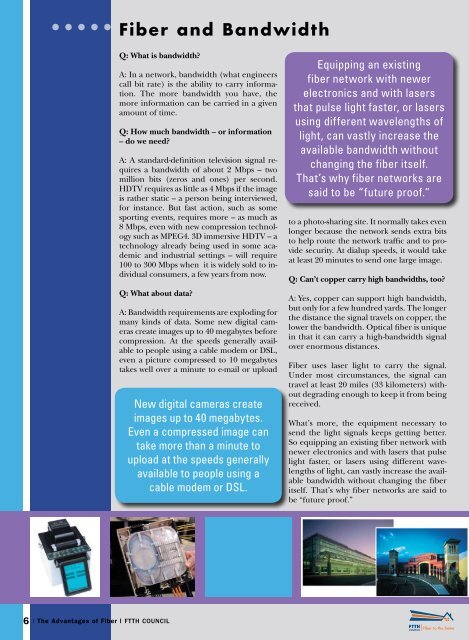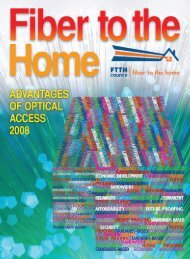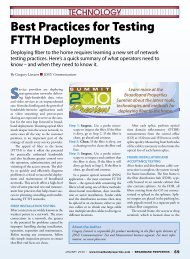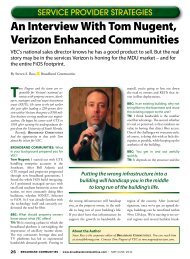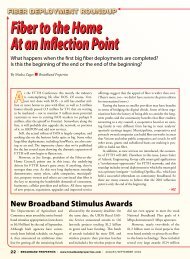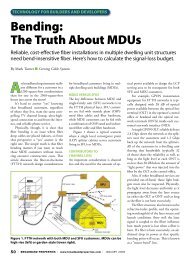Download - Broadband Properties
Download - Broadband Properties
Download - Broadband Properties
You also want an ePaper? Increase the reach of your titles
YUMPU automatically turns print PDFs into web optimized ePapers that Google loves.
Fiber and Bandwidth<br />
Q: What is bandwidth?<br />
A: In a network, bandwidth (what engineers<br />
call bit rate) is the ability to carry information.<br />
The more bandwidth you have, the<br />
more information can be carried in a given<br />
amount of time.<br />
Q: How much bandwidth – or information<br />
– do we need?<br />
A: A standard-definition television signal requires<br />
a bandwidth of about 2 Mbps – two<br />
million bits (zeros and ones) per second.<br />
HDTV requires as little as 4 Mbps if the image<br />
is rather static – a person being interviewed,<br />
for instance. But fast action, such as some<br />
sporting events, requires more – as much as<br />
8 Mbps, even with new compression technology<br />
such as MPEG4. 3D immersive HDTV – a<br />
technology already being used in some academic<br />
and industrial settings – will require<br />
100 to 300 Mbps when it is widely sold to individual<br />
consumers, a few years from now.<br />
Q: What about data?<br />
A: Bandwidth requirements are exploding for<br />
many kinds of data. Some new digital cameras<br />
create images up to 40 megabytes before<br />
compression. At the speeds generally available<br />
to people using a cable modem or DSL,<br />
even a picture compressed to 10 megabytes<br />
takes well over a minute to e-mail or upload<br />
New digital cameras create<br />
images up to 40 megabytes.<br />
Even a compressed image can<br />
take more than a minute to<br />
upload at the speeds generally<br />
available to people using a<br />
cable modem or DSL.<br />
Equipping an existing<br />
fiber network with newer<br />
electronics and with lasers<br />
that pulse light faster, or lasers<br />
using different wavelengths of<br />
light, can vastly increase the<br />
available bandwidth without<br />
changing the fiber itself.<br />
That’s why fiber networks are<br />
said to be “future proof.”<br />
to a photo-sharing site. It normally takes even<br />
longer because the network sends extra bits<br />
to help route the network traffic and to provide<br />
security. At dialup speeds, it would take<br />
at least 20 minutes to send one large image.<br />
Q: Can’t copper carry high bandwidths, too?<br />
A: Yes, copper can support high bandwidth,<br />
but only for a few hundred yards. The longer<br />
the distance the signal travels on copper, the<br />
lower the bandwidth. Optical fiber is unique<br />
in that it can carry a high-bandwidth signal<br />
over enormous distances.<br />
Fiber uses laser light to carry the signal.<br />
Under most circumstances, the signal can<br />
travel at least 20 miles (33 kilometers) without<br />
degrading enough to keep it from being<br />
received.<br />
What’s more, the equipment necessary to<br />
send the light signals keeps getting better.<br />
So equipping an existing fiber network with<br />
newer electronics and with lasers that pulse<br />
light faster, or lasers using different wavelengths<br />
of light, can vastly increase the available<br />
bandwidth without changing the fiber<br />
itself. That’s why fiber networks are said to<br />
be “future proof.”<br />
6 | The Advantages of Fiber | FTTH Council


